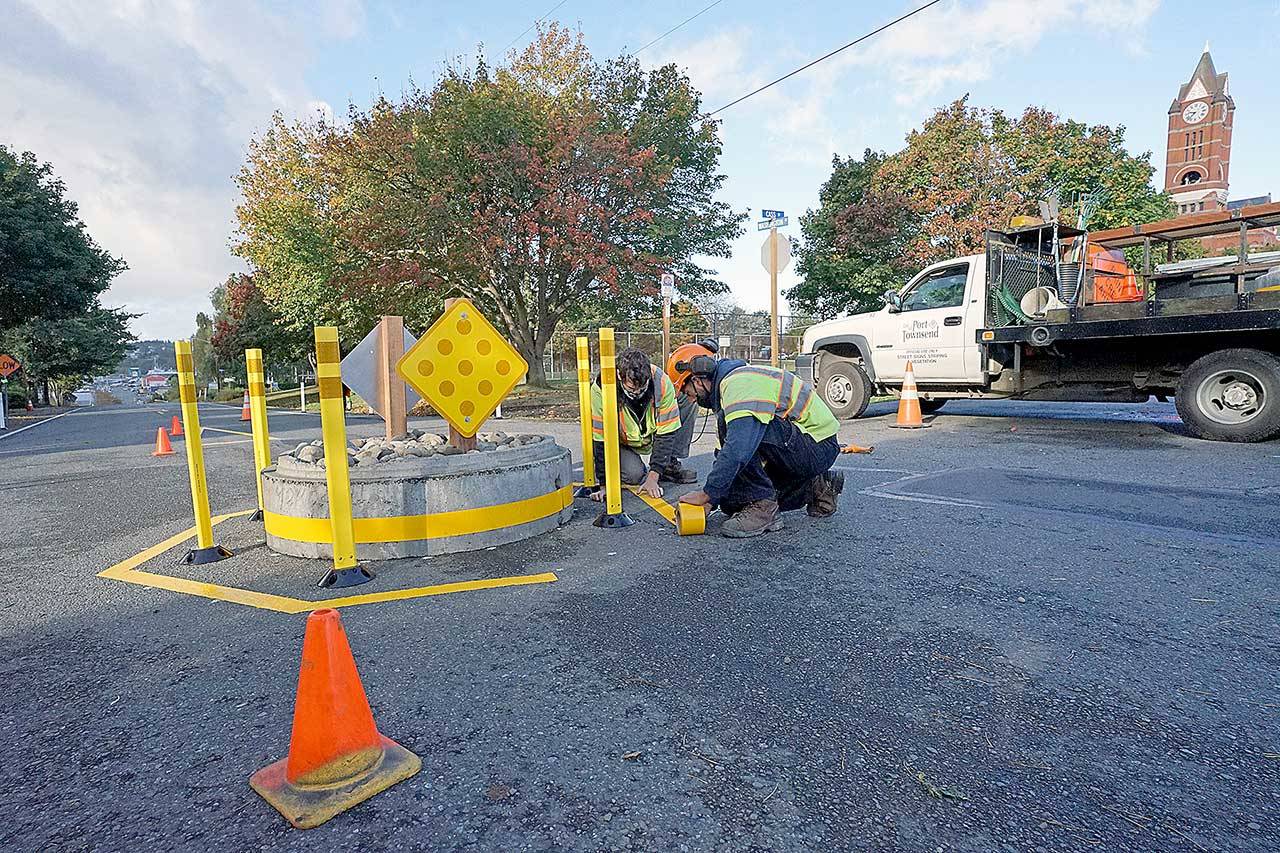PORT TOWNSEND — The city of Port Townsend has teamed up with residents along Washington Street to see if they can get motorists traveling between Sims Way and downtown to honor the 25 mph speed limit.
Two mini traffic circles were installed Monday in the center of the roadway — one at Cass Street and another at Benton Street — as part of a 60-day trial period during which traffic speeds and volumes will be measured.
“This will be relatively new for Port Townsend and so we want to make sure they work,” Steve King, the city’s public works director, told members of the City Council’s transportation committee in September.
“We want to know if this solution produces effective outcomes before we spend money in other parts of the city.”
The city plans to compare speed and volume data collected during the next two months with data collected during October 2019.
Last year’s data found most motorists traveled at 28 mph, and that between 3,400 and 3,700 vehicles used that street each day.
Staff also plan to assess whether the circles have unintended consequences, such as causing motorists to avoid the street altogether by taking alternative routes.
“Sometimes you calm one street and it just pushes the cars to another street,” King said. “If we do see a diversion of traffic onto other streets, we will need to evaluate if that’s a harmful diversion or not and make sure we didn’t create a problem somewhere else. We’ll actually go out and watch it work for a while.”
If the circles are effective, they could be replaced by permanent fixtures at an estimated cost of $5,000 per circle — a bill residents along that street have agreed to pay, King said.
“The city would provide the labor of installation,” he said. “That’s not an uncommon strategy, and it’s one that the Washington Street neighbors brought forward recognizing the city’s funding challenges.”
The city is bracing for a projected revenue shortfall of about $1 million in 2021.
On Monday night, the City Council discussed potential cuts amounting to $765,000, with $186,000 coming out of the street fund.
Beyond the circles, the city considered two other options: medians, which King said would cost twice as much, and speed radar boards.
“They [radar boards] are effective to a point,” he said. “After a while, traffic will begin to ignore the radar board unless there’s a lot of enforcement that goes along with it.”
King and city engineer Dave Peterson have met with area residents several times since February, when Washington Street resident Harriet Cannon presented the City Council with a petition signed by 110 of her neighbors urging the city to do something.
“There has been in the last couple of years a dramatic change in traffic speed and intensity, and it’s accelerating,” Cannon told the council. “At certain times of the day and on weekends, 40 is the new 25.”
Residents have suggested reducing the speed limit to 20 mph, King said, but that would require an engineering study and council approval. Given the configuration of the road, a study likely would not support a speed-limit reduction, he said.
While presenting the petition in February, Cannon compared Washington Street to Water and Lawrence streets, pointing out that those streets have sidewalks, bike lanes and crosswalks, plus “a cultural civility.”
In late September, city workers installed the only crosswalk along that stretch at Harrison Street near the Port Townsend Post Office.
“Residents can no longer back out of their driveways, cars don’t stop for us to cross the street,” Cannon said in February. “RVs and delivery trucks too large for the street force pedestrians to jump into the culvert.”
Washington Street is one of many areas in the city that need traffic-calming infrastructure, King said. Deputy Mayor David Faber agreed, saying lower-income neighborhoods would be less able to foot the bill.
While acknowledging the project’s value to a residential street with no sidewalks and a relatively high volume of traffic, Faber said it leaves “a bad taste in my mouth because it does seem to exacerbate that [equity] issue.
“I know there are a lot of parts of the city that have long felt comparatively ignored in terms of safety,” Faber said. “Discovery Road is a great example. That is one that’s long been on the table — same with 14th Street and parts of Hastings [Avenue].”
That’s why King said he hopes the success of this project could lead to a city-funded mini-grant program — awarding $5,000 to $10,000 grants — to pay for similar projects in other neighborhoods.
“It would give lower-income areas the ability to achieve the same outcome as what we’re doing here on Washington Street,” he said. “This is an example of how we’re using a demonstration to basically build our streets program.”
________
Jefferson County senior reporter Nicholas Johnson can be reached by phone at 360-417-3509 or by email at njohnson@peninsuladailynews.com.

